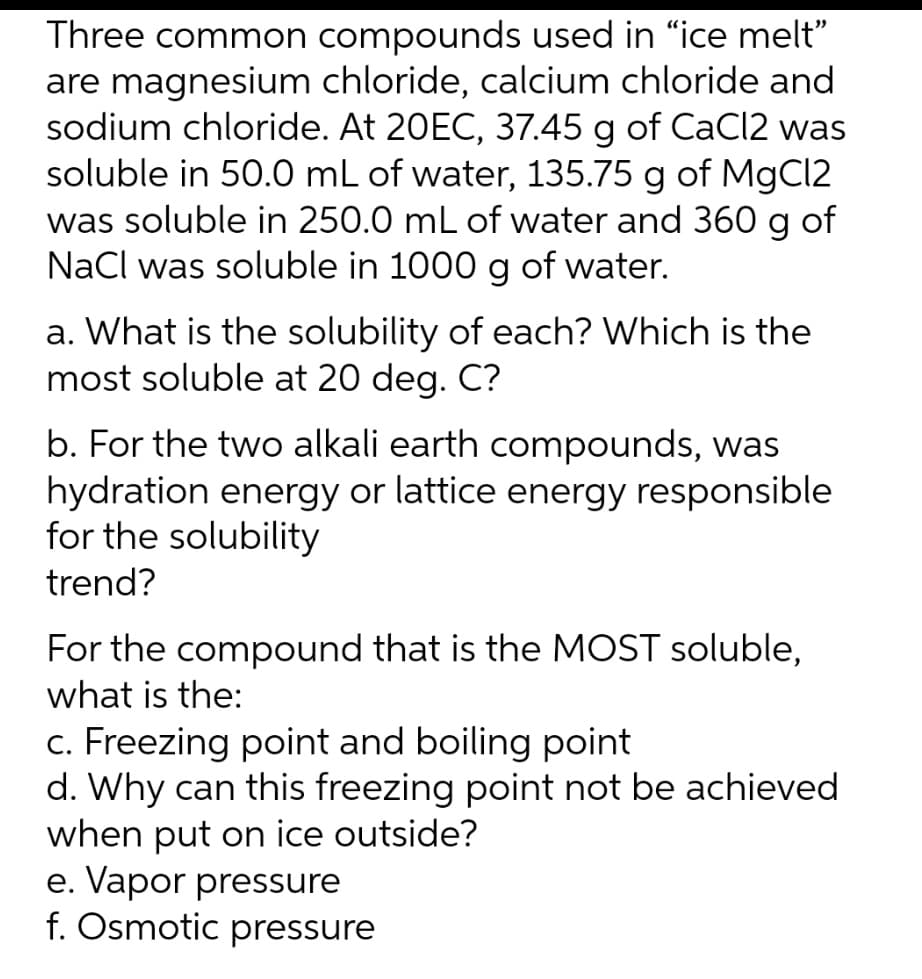Three common compounds used in "ice melt" are magnesium chloride, calcium chloride and sodium chloride. At 20EC, 37.45 g of CaCl2 was soluble in 50.O mL of water, 135.75 g of MgC12 was soluble in 250.0 mL of water and 360 g of NaCl was soluble in 1000 g of water. a. What is the solubility of each? Which is the most soluble at 20 deg. C? b. For the two alkali earth compounds, was hydration energy or lattice energy responsible for the solubility trend? For the compound that is the MOST soluble, what is the: c. Freezing point and boiling point
Three common compounds used in "ice melt" are magnesium chloride, calcium chloride and sodium chloride. At 20EC, 37.45 g of CaCl2 was soluble in 50.O mL of water, 135.75 g of MgC12 was soluble in 250.0 mL of water and 360 g of NaCl was soluble in 1000 g of water. a. What is the solubility of each? Which is the most soluble at 20 deg. C? b. For the two alkali earth compounds, was hydration energy or lattice energy responsible for the solubility trend? For the compound that is the MOST soluble, what is the: c. Freezing point and boiling point
Chemistry: The Molecular Science
5th Edition
ISBN:9781285199047
Author:John W. Moore, Conrad L. Stanitski
Publisher:John W. Moore, Conrad L. Stanitski
Chapter9: Liquids, Solids, And Materials
Section: Chapter Questions
Problem 103QRT
Related questions
Question
help please

Transcribed Image Text:Three common compounds used in "ice melt"
are magnesium chloride, calcium chloride and
sodium chloride. At 20EC, 37.45 g of CaCl2 was
soluble in 50.0 mL of water, 135.75 g of MgCI2
was soluble in 250.0 mL of water and 360 g of
NaCl was soluble in 1000 g of water.
a. What is the solubility of each? Which is the
most soluble at 20 deg. C?
b. For the two alkali earth compounds, was
hydration energy or lattice energy responsible
for the solubility
trend?
For the compound that is the MOST soluble,
what is the:
c. Freezing point and boiling point
d. Why can this freezing point not be achieved
when put on ice outside?
e. Vapor pressure
f. Osmotic pressure
Expert Solution
This question has been solved!
Explore an expertly crafted, step-by-step solution for a thorough understanding of key concepts.
This is a popular solution!
Trending now
This is a popular solution!
Step by step
Solved in 4 steps

Knowledge Booster
Learn more about
Need a deep-dive on the concept behind this application? Look no further. Learn more about this topic, chemistry and related others by exploring similar questions and additional content below.Recommended textbooks for you

Chemistry: The Molecular Science
Chemistry
ISBN:
9781285199047
Author:
John W. Moore, Conrad L. Stanitski
Publisher:
Cengage Learning

Chemistry: Principles and Practice
Chemistry
ISBN:
9780534420123
Author:
Daniel L. Reger, Scott R. Goode, David W. Ball, Edward Mercer
Publisher:
Cengage Learning

Chemistry & Chemical Reactivity
Chemistry
ISBN:
9781133949640
Author:
John C. Kotz, Paul M. Treichel, John Townsend, David Treichel
Publisher:
Cengage Learning

Chemistry: The Molecular Science
Chemistry
ISBN:
9781285199047
Author:
John W. Moore, Conrad L. Stanitski
Publisher:
Cengage Learning

Chemistry: Principles and Practice
Chemistry
ISBN:
9780534420123
Author:
Daniel L. Reger, Scott R. Goode, David W. Ball, Edward Mercer
Publisher:
Cengage Learning

Chemistry & Chemical Reactivity
Chemistry
ISBN:
9781133949640
Author:
John C. Kotz, Paul M. Treichel, John Townsend, David Treichel
Publisher:
Cengage Learning

Chemistry & Chemical Reactivity
Chemistry
ISBN:
9781337399074
Author:
John C. Kotz, Paul M. Treichel, John Townsend, David Treichel
Publisher:
Cengage Learning

Principles of Modern Chemistry
Chemistry
ISBN:
9781305079113
Author:
David W. Oxtoby, H. Pat Gillis, Laurie J. Butler
Publisher:
Cengage Learning

Chemistry: An Atoms First Approach
Chemistry
ISBN:
9781305079243
Author:
Steven S. Zumdahl, Susan A. Zumdahl
Publisher:
Cengage Learning